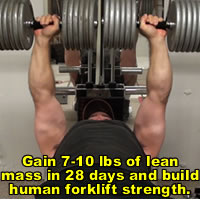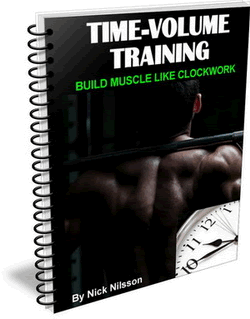Intensity techniques for chest training are often VERY overused (e.g. forced reps) and often VERY ineffective (e.g. forced reps).
Sure, you feel like you're working harder, but I have to say, I'd rather get more productive results rather than just feeling like I'm working harder.
So I've got a bench press technique for you here that's going to do just that.
This one is going to take a bit of explaining...but once you mentally understand how it works, you're going to be AMPED to try it out next time you're in the gym.
It's an intensity technique (in this case done with the bench press, though it can be easily applied to other exercises) that targets ALL your major muscle fibers types in one set.
You're going to hit Type 1 endurance fibers, Type 2a moderate/heavy strength fibers and Type 2b explosive/very heavy fibers, all in one set.
This technique is going to produce MAXIMUM hypertrophy and fiber activation for your chest in a minimum of time.
The base technique is one that I call Triple Add Sets. I've talked about this one before and you may already be familiar with it.
Essentially, that technique is similar to a Triple Drop Set in that you do a three-part set, changing weights on each part. In a Drop Set, you reduce the weight. In an Add set, you INCREASE the weight on each successive part of the set.
The way I do Add sets is by starting with a light weight for high reps, e.g. 30 to 50 reps. Then increase the weight and do a set of 6 to 8 reps. Then increase again and do a set of 1 to 3 reps. Each portion of that add set targets a different set of muscle fibers.
For example, if I was doing a Triple Add Set with dumbbell bench press, I would use 25 lb dumbbells for a set of 50 reps. Then a brief rest (10 seconds or so) then pick up a pair of 50 lb dumbbells and do a set of 8 reps. Then rest 10 seconds then pick up a pair of 100 lb dumbbells and do a set of 2 reps.
At the end of that set, you've hit all your major muscle fibers types and stimulated massive growth and strength gains.
The main issue I found with the Triple Add Set done like this is having to line up three separate sets of weights. It's time-consuming even in my home gym and MUCH tougher to accomplish in a normal gym with lots of people running around, looking for weights.
And that's how Range-Of-Motion Triple Add Sets were born.
Instead of starting light for high reps and increasing the weight and decreasing the reps from there, you're going to use the SAME weight on all portions of the set.
Instead of increasing the weight, you're going to increase the RANGE OF MOTION.
This is what is going to make it tougher. And it's also what's going to make it much easier to work with in a crowded gym than having 3 sets of weights in front of you.
|
Phase 1 - Short Range of Motion, High-Rep Training for Type 1 Endurance Muscle Fibers
In this first part of the set, you'll be doing just the top few inches of the range of motion of the bench press. Since is has the best leverage and is the strongest part of the range, you'll be able to get a LOT of reps with it.
We're aiming for about 30+ reps on this one.
Select a weight you could normally hit about 12 to 15 FULL-range reps with. I'm using 225 on the bar here. Now just rep out in that top range of motion.

As you can see, this is a VERY short range of motion.

Crank out as many reps as you can...this is going to work those Type 1 endurance fibers. As a major benefit, you're working them with relatively heavy weight here, too, which will help them achieve some actual growth, which is not easy to accomplish with Type 1 muscle fibers.
Phase 2 - Medium Range of Motion, Moderate-Rep Training for Type 2a Muscle Fibers
Once you've finished your high-rep, short-range set, rack the bar and rest 10 to 15 seconds. Now lie back down and get set for Phase 2.
You're going to be doing about HALF the range of motion of the exercise this time, staying just above the sticking point of the bench press (which is about 1/3 of the way up - it varies by individual).
We want to stay above the sticking point to stay in favorable leverage and get the reps.

The elbows are almost at 90 degrees (just slightly above that point to maintain good leverage).

Use a deliberate movement with this. Lower the weight to the point just above the sticking point, pause, then press up and repeat. There should be no bouncing from the bottom here as we want to develop tension in the chest.
You should be able to hit about 6 to 8 reps in this half range of motion. This targets the Type 2a muscle fibers that respond well to medium reps and time under tension.
Phase 3 - Full Range of Motion, Low-Rep Training for Type 2b Muscle Fibers
Now it gets interesting...
You're going to re-rack the weight, take your brief rest then do as many FULL range reps as you can. This will most likely be 1 to 3 reps here, depending on your fiber-type makeup for the upper body and the weight you selected originally.
Treat this as a near-maximal rep in how you set up for it. Make sure everything is tight. You've got your legs braced and your shoulders tight behind your body. Lower the bar under control then press up with explosive power.

When doing these in a rack, ensure that the safety rails are set just slightly below the bottom point of the exercise.

That's the last straw!
Once you hit that rep, rack the weight and you're done. You'll feel a HUGE pump...possibly unlike anything you've ever felt before in your chest...because of the hard work you've put on every muscle fiber type in one shot.
This technique is VERY powerful and shouldn't be used more than once a week to keep your nervous system from grinding down. You can do it for 1 to 3 sets when you actually do use...once through the 3 parts counts as one set.
You can also perform Range-of-Motion Triple Add Sets for Chin-Ups for your back.
Also, learn how to perform Range-of-Motion Triple Add Sets for Biceps and Triceps here.
![]()
More From Fitstep.com
Share This Page...
---
Home -> Exercise Library -> Chest Exercises -> ROM Triple Add Sets Bench Press



